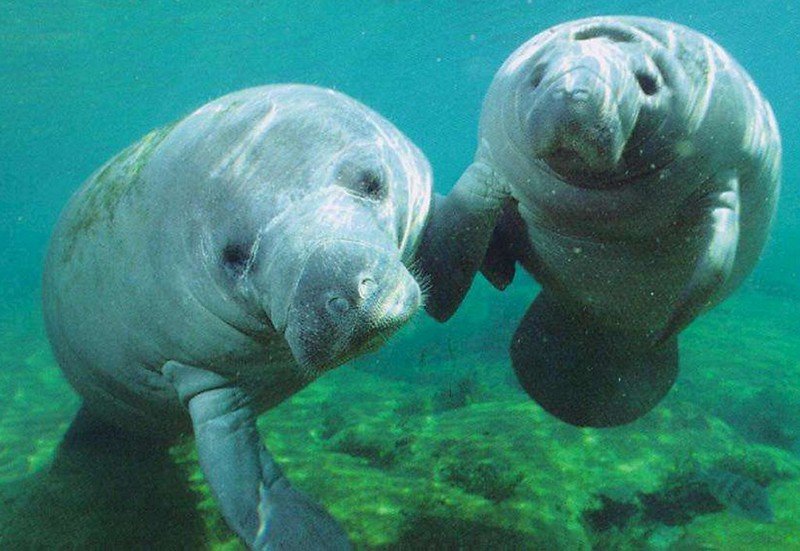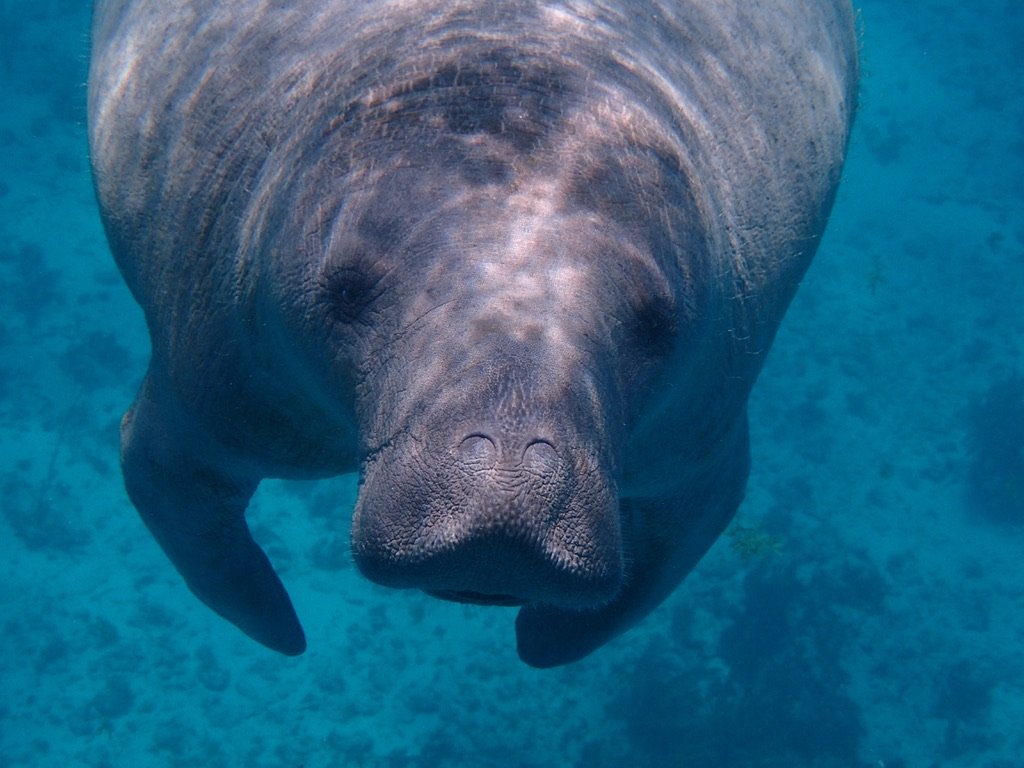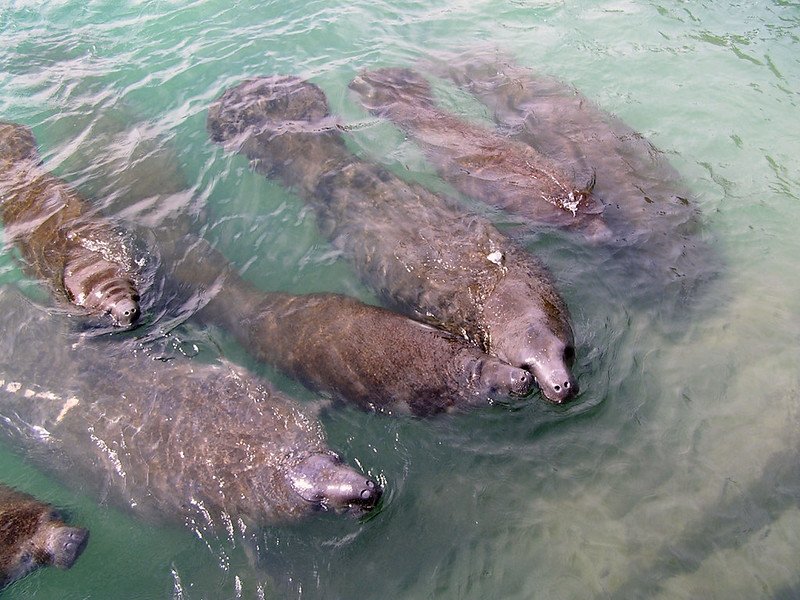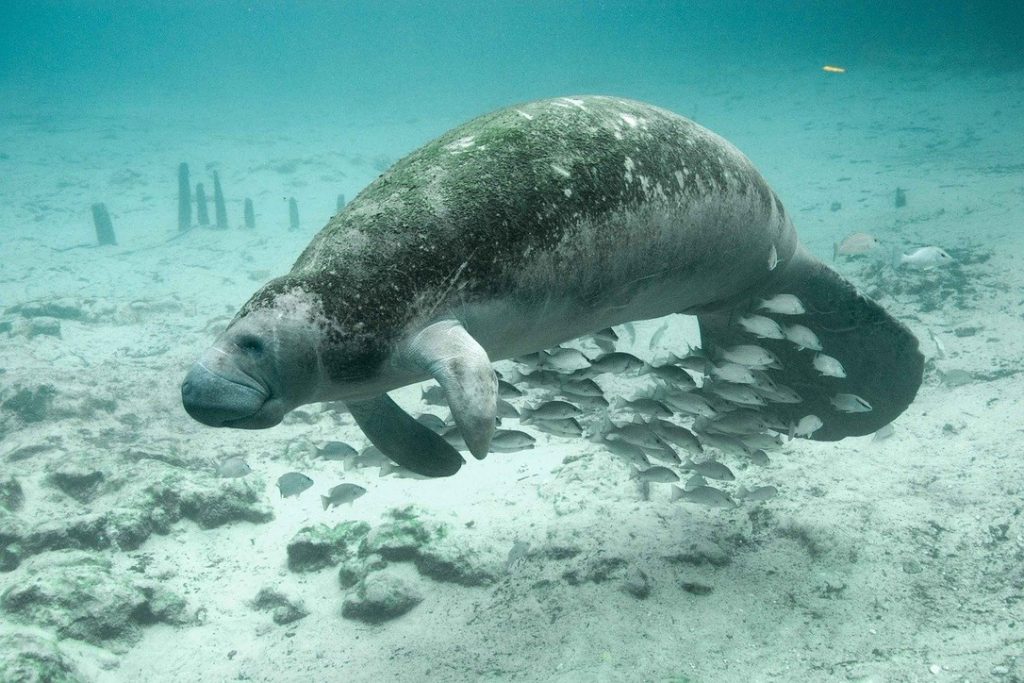
Manatees are also called sea cows.
Have you ever seen a manatee in the wild? It is an amazing experience. You almost want to hold your breath while in their presence so you don’t scare them away.
It is hard not to love this gentle giant marine mammal. And there is so much to learn about them. Let’s start with some fun manatee facts. But first, watch this video of 2 manatees swimming & be prepared to fall in love.
Some cool manatee facts
![]()

The manatee uses its upper lip to gather food much like an elephant, its closest relative, uses its trunk.
First, how many species of manatee exist? In the US, we have the West Indian manatee, which is the biggest. Generally, they live in coastal Florida waters (the Florida manatee) or in the Caribbean (the Caribbean manatee).
Sometimes they can be found along the eastern coast and have been sighted as far north as Cape Cod, Massachusetts. The two other species live in the Amazon & Africa.
Second, while they are similar to other marine mammals, like seals & walruses, their closest relative is the elephant. Now that’s weird. How can this even be possible?
Well, both the elephant & manatee have wrinkled, coarse skin with little bristly hairs covering their bodies. Their toenails are the same except the elephant has feet and the manatee has flippers. Hmm, I have never heard of toenails on a flipper! But sure enough, they have three to four tiny nails.
And manatees use their upper lips to forage for vegetation much like the elephant uses its trunk to grasp food. To learn more about their closest cousin, check out our Elephant cool facts.
How much do manatees weigh & what do they eat?
![]()

Manatees open their nostrils when surfacing to breathe. When underwater, they have closed flaps over their noses.
Are manatees mammals? Sure, they’re actually marine mammals meaning they live in the water but need air to breathe. Every 5 minutes, they generally surface for a quick gulp of air before settling back underwater. Unless they are resting & then they might stay underwater for 20 minutes. To keep them from drowning, their nostrils have closed flaps while underwater which opens when they surface to breathe.
Plus, they eat a lot. Adult manatees weigh on average 1,000 pounds so they need a lot of food. They eat over 100 pounds of food a day or 10% of their weight. Every single day!
But one little-known manatee fact is the cost to feed a rescued manatee? Over $120 a day for each manatee in human care and all they eat is high-quality romaine lettuce. Now, that’s a lot of lettuce!
So what do they eat in the wild? Seagrass, mangrove leaves, water hyacinths and algae are all favorite foods.
And because they eat so much plant material with sand & grit mixed in, they have marching molars. Now that is a term I don’t know. As the front teeth wear down & fall out, the back molars are constantly growing & moving forward. A very cool manatee fact.
What’s so special about the baby calves?
![]()

Baby manatees nurse underwater from their moms for up to 2 years. Photo: Psyberartist/Flickr
First of all, baby manatees, called calves, are really cute. And they’re born underwater which is pretty special.
Mom manatees only have babies once every 2-5 years and rarely have more than one. The mom is pregnant with the baby for 12 months before giving birth. Now that’s a very long time but it’s necessary since the calf weighs about 65 pounds when born.
Babies are born underwater and must swim to the surface for their first breath. Wow, but it gets even more interesting. Babies nurse underwater & will stay with their mom for up to 2 years. Meanwhile, the dad has no part in raising the calf.
Where do manatees live?
![]()

Manatees congregate in warm water during the winters.
Can manatees live in freshwater? How about saltwater? Actually, manatees live in both, moving back & forth with no problems. I’ve seen manatees in the Atlantic ocean, brackish Florida rivers & crystal clear springs.
In the winter, Florida manatees move north to stay warm which seems odd on the surface. Isn’t it colder the farther north you go? Well, yes but the manatees are looking for warm water as they need water above 68 degrees to survive.
Natural springs in northern Florida have a year-round temperature of 72 degrees so the manatees congregate there in winter. Sometimes 400-500 will be in a single spring! They also will gather around warm water emitted from power plants.
Are manatees endangered?
![]()

Manatees need our help to continue to thrive.
In 2017, USFWS downgraded the West Indian manatee from endangered to threatened. So what exactly does that mean?
When an animal (or plant) is moved off the endangered species list, it means it is no longer considered in immediate danger of extinction. However, threatened means they are still vulnerable to extinction in the foreseeable future. Seems like splitting straws to me.
Manatees’ biggest threat today appears to be starvation. While boating accidents often occur where manatees are hit by a boat or its propeller, the main problem now is a lack of food. Their main food source, seagrass, is being destroyed by pollutants and toxic algae blooms. In just 2021, almost 15% of the manatee population have died, many from a lack of enough food, which is unprecedented.
So what can be done? In an unusual step, the USFWS announced in Dec 2021, they will begin feeding manatees in the Indian River Lagoon where over 95% of the seagrass is gone.
Hundreds of these gentle giants congregate in the lagoon each winter staying warm in the waters the power plant discharges. Hopefully, this experimental feeding will help the manatees get enough food while longer-term solutions are figured out.
How can you help?
![]()

Leaving manatees alone is one way you can help. Photo: USFWS/Flickr
Many folks might now think feeding manatees will help them since USFWS will be providing them food. But all manatees are protected by the Mammal Marine Protection Act making it illegal to feed, harass, or harm these gentle giants. So no, you should not feed them.
However, if you see one hurt or struggling, please call 1-800-404-FWCC & report it to USFWS. One of the best things you can do is help with shoreline clean-up, especially old fishing lines which can entangle a manatee.
Help spread the word about these magnificent animals by sharing posts on social media. And you can donate to organizations that work to protect the manatee. We suggest one of our partner’s Defenders of Wildlife who works tirelessly to save our native wildlife.
And maybe you figured out there are way more than 7 manatee facts in our story although the title says seven. There are just too many cool things to tell you about these amazing creatures. We hope you have fallen in love, just like us.
